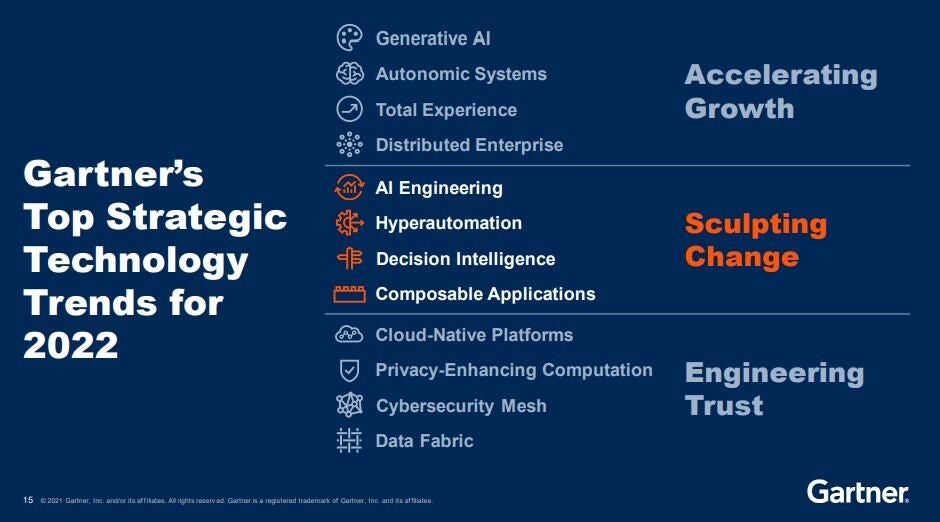
Image: Urupong, Getty Images/iStockphoto
CEOs have three priorities for 2022: growth, digitalization and efficiency, and CIOs add value to those with force multipliers, creative technology and scalable foundation. Gartner research vice president David Groombridge announced the top strategic technology trends that organizations need to explore in 2022 during a session at Gartner IT Symposium/Xpo Americas Monday.
CEOs and boards are striving to grow and are willing to spend for digital investments to make direct connections with customers, Groombridge said. He cited 12 technologies that can enhance organizational efforts to accelerate growth, engineer trust and sculpt change.

Image: Gartner
1. Generative artificial intelligence
A new artificial intelligence coming to market is generative AI, which is the use of machine learning methods that learn about content or objects from their data and use it to generate new, completely original, realistic artifacts.
Most AI models today are trained to drive conclusions, Groombridge said. Generative AI learns about artifacts from data. It could disrupt creative processes in engineering, manufacturing, architecture and design, he said.
Generative AI can be used in many ways, including creating software code, identifying new products, facilitating drug development and targeted marketing. It can also be misused for scams, fraud, political disinformation, forged identities and more. By 2025, Gartner expects generative AI to account for 10% of all data produced, up from less than 1% today.
2. Data fabric
The number of data and application silos has surged in the last decade, while the number of skilled personnel in data and analytics teams has either stayed constant or even dropped, Groombridge said. Data fabrics–flexible, resilient integration of data across platforms and business users–have emerged to simplify an organization’s data integration infrastructure and create a scalable architecture that reduces the technical debt seen in most D&A teams due to the rising integration challenges.
The real value of data fabric is its ability to dynamically improve data usage with its built-in analytics, cutting data management efforts by up to 70% and accelerating time to value, according to Gartner.
SEE: 3 steps to build a data fabric to integrate all your data tools (TechRepublic)
3. Distributed enterprise
With the rise in remote and hybrid working patterns, traditional office-centric organizations are evolving into distributed enterprises composed of geographically dispersed workers.
“This requires CIOs to make major technical and service changes to deliver frictionless work experiences, but there is another side to this coin: the impact on business models,” Groombridge said. Every organization must reconfigure its delivery model to embrace distributed services, he said. “The world didn’t think they’d be trying on clothes in a digital dressing room two years ago.”
Gartner is projecting that by 2023, 75% of organizations that exploit distributed enterprise benefits will realize revenue growth 25% faster than competitors.
4. Cloud-native platforms
To truly deliver digital capabilities anywhere and everywhere, enterprises must turn away from the familiar “lift and shift” migrations and toward CNPs. CNPs use the core capabilities of cloud computing to provide scalable and elastic IT-related capabilities as a service to tech creators using internet technologies, which deliver faster time to value and reduced costs.
Consequently, Gartner predicts that cloud-native platforms will serve as the foundation for more than 95% of new digital initiatives by 2025—up from less than 40% in 2021.
5. Autonomic systems
As enterprises grow, traditional programming or simple automation will not scale, according to Groombridge. Autonomic systems are self-managing physical or software systems that learn from their environments. Autonomic systems can dynamically modify their own algorithms without an external software update, enabling them to rapidly adapt to new conditions in the field.
Autonomic systems will become common in robots, drones, manufacturing machines and smart spaces, he said.
6. Decision intelligence
Decision intelligence is a discipline used to improve decision-making by explicitly understanding and engineering how decisions are made, and outcomes evaluated, managed and improved by feedback. Gartner predicts that in the next two years, one-third of large organizations will be using decision intelligence for structured decision-making to improve competitive advantage.
7. Composable applications
Demand for business adaptability is required in today’s continuously changing business environment. This requires technology architecture that supports fast, safe and efficient application change, Groombridge said. Composable application architecture empowers this adaptability, and those who have adopted a composable approach will outpace the competition by 80% in the speed of new feature implementation, he said.
8. Hyperautomation
Hyperautomation enables accelerated growth and business resilience by rapidly identifying, vetting and automating as many processes as possible.
Gartner’s research shows that the top-performing hyperautomation teams focus on three key priorities: improving the quality of work, speeding up business processes and enhancing decision-making agility, Groombridge said.
9. Privacy-enhancing computation
Besides dealing with maturing international privacy and data protection legislation, CIOs must avoid any loss of customer trust resulting from privacy incidents, he said. Gartner expects 60% of large organizations to use one or more privacy-enhancing computation techniques by 2025.
PEC techniques protect personal and sensitive information at a data, software or hardware level. They securely share, pool and analyze data without compromising confidentiality or privacy, according to Gartner.
10. Cybersecurity mesh
Data is only useful if enterprises can trust it,” Groombridge said. “Today, assets and users can be anywhere, meaning the traditional security perimeter is gone. This requires a cybersecurity mesh architecture.”
CSMA helps provide an integrated security structure and posture to secure all assets, regardless of location, he said. By 2024, organizations adopting a CSMA to integrate security tools to work cooperatively will reduce the financial impact of individual security incidents by an average of 90%, according to Gartner.
11. AI engineering
IT leaders struggle to integrate AI within applications, wasting time and money on AI projects that are never put in production or struggling to retain value from AI products once released.
So-called fusion teams working on AI will create a real differentiator for their organizations if they can continually enhance value through rapid AI change, Groombridge said. They need composable apps, which are built for modular components, he said. This will increase the efficiency of fusion teams.
Composable apps are built from packaged business capabilities. PBCs create reusable business models that these teams can use to rapidly create a composed app integrated into a data fabric with UI over it, Groombridge said. “PBCs are the molecules, and fusion teams are the scientists creating them.”
Using composable apps increases the number of apps delivered while cutting delivery time, he said.
Already, companies including Georgia Pacific, Unity Health and Axon are operationalizing AI, he said. But for AI to be accepted “its ethics must be beyond exception,” Groombridge added.
12. Total experience
TX is a force multiplier for a growth strategy that combines customer experience, employee experience, user experience and multi-experience disciplines, Groombridge said. He advised organizations to leverage that by forming fusing teams with executive sponsors.
Under the total experience approach, all discipline leaders should be equally responsible for meeting the combined needs of employees and customers, he said. Groombridge added that “traditional management approaches will not scale.”
The goal of TX is to drive greater customer and employee confidence, satisfaction, loyalty and advocacy.
The top strategic technology trends for 2022 will drive significant disruption and opportunity over the next five to 10 years, according to Gartner.